Buddleia spp.
“It’s called butterfly bush,” a coworker at my parents’ flower shop told me, “and it really does attract butterflies!”
I was 10, I collected butterfly wings, and I was intrigued. The next day she brought me a clipping complete with a long, arching purple bloom.
Knowing I had to have a butterfly bush of my own, I dipped the woody end in an ancient pot of rooting powder, poked it into a pot of soil in my parents’ greenhouse, and promptly forgot about it.
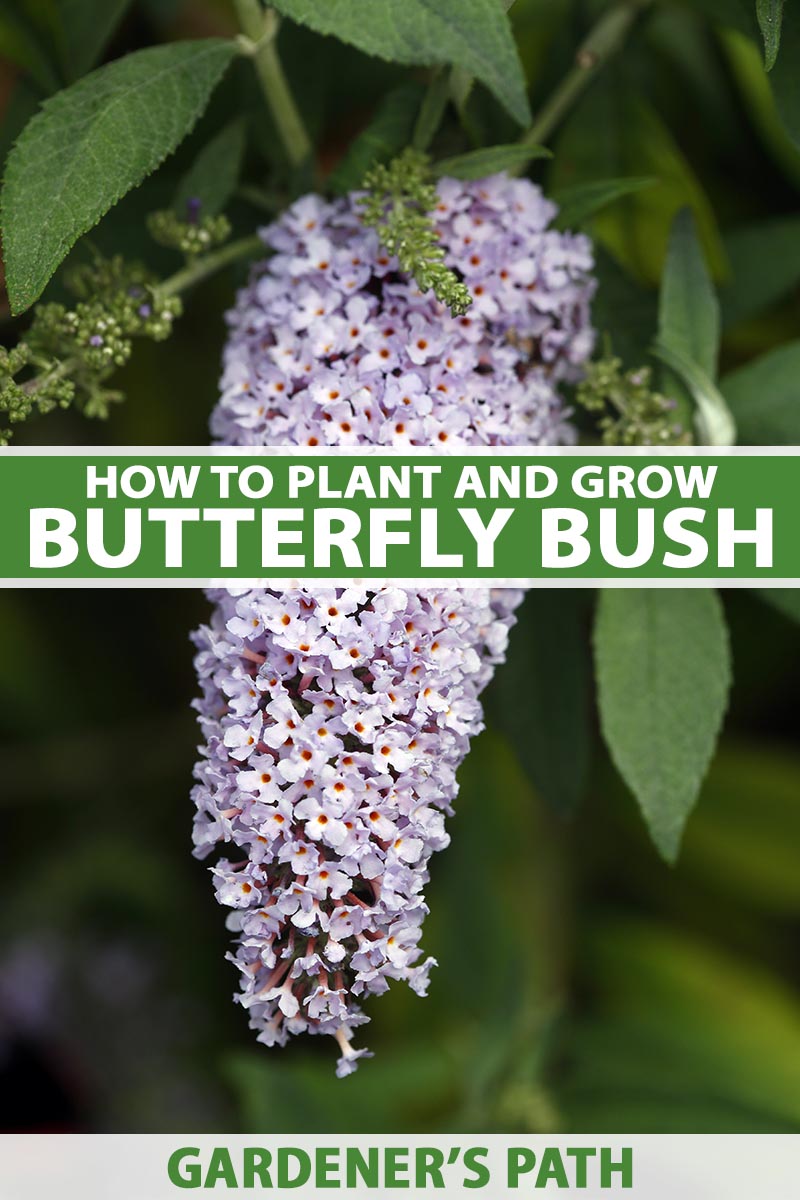
We link to vendors to help you find relevant products. If you buy from one of our links, we may earn a commission.
When I finally remembered to look at it again, the bloom was a crispy brown and the leaves were dry. Clearly, I had no idea what I was doing. But I’ve learned a lot about propagating plants like this one since the age of 10, and I’m here to help you find success in your own garden!
If you love watching butterflies flit from bloom to bloom like I do, and want to attract a variety of these colorful insects to your garden, Buddleia may be the shrub for you!
Sometimes called summer lilac, Buddleia is a fragrant, resilient, deciduous bush that attracts butterflies with its sweet nectar, and blooms exuberantly during the heat of the summer when many other garden plants aren’t flowering.

Below you’ll find everything you need to know to grow and care for your very own butterfly bush, including how to avoid the disappointment of a crispy, unrooted cutting during propagation.
What You’ll Learn
Cultivation and History
In the 1920s, the original common name for plants in this genus, summer lilac, fell out of favor and was replaced with butterfly bush, for obvious reasons: the masses of colorful, nectar-rich blooms attract many of the large, bright, winged insects that so many of us love to see in the garden, plus other pollinators such as bees and even birds.

The name summer lilac is still occasionally used, often for B. davidii.
The name Buddleja (spelled with a “j”) was given to the genus by Linneaus, who named it after botanist Adam Buddle, although Buddleia is preferred by most botanists today. The most common garden species, B. davidii, is named after Pere Armond David, the guy who shipped the first live panda from China to Paris.
The 100-plus species in the Buddleia genus are native to areas of Asia, Africa, and tropical parts of the Americas, although most butterfly bushes found in our gardens today are descendants of the aforementioned species, originally from central China.
Since their beginnings in American gardens, they’ve gone wild. Hardy in Zones 5-10, and able to tolerate the cold well, butterfly bush has naturalized across a wide swathe of North American climates.
In some areas B. davidii is even considered invasive and will outcompete native plants that supply food for pollinators. Thus, breeding programs today attempt to produce sterile hybrids, which are unable to spread via seed.
Before heading to the nursery for your own butterfly bush or ordering one online, do the necessary research to find out if it is listed as an invasive plant in your area.
Check with the USDA invasive plants list or the extension service in your state. Be sure to choose a sterile hybrid if it’s considered invasive, or look for different plants that attract pollinators to grow as an alternative.
There are over 100 cultivars of butterfly bush today, each with their own characteristic bloom color, mature plant size, growth habit, and leaf shape.
Flowers can come in both bright and muted shades of pink, purple, and white, leaves can be dark green to gray-green in color, and shrubs can grow to be three to 12 feet tall and wide at maturity.
Propagation
In nature, rather than propagating vegetatively, most butterfly bush species rely on the dispersal of huge numbers of seeds to reproduce.
However, in a garden setting, they are easy to propagate in a variety of ways – even sterile cultivars.
From Stem Cuttings
Rooting stem cuttings is the easiest way to clone your favorite butterfly bush, if the plant is healthy. Despite my first failed attempt as a child, they do root quickly and easily.
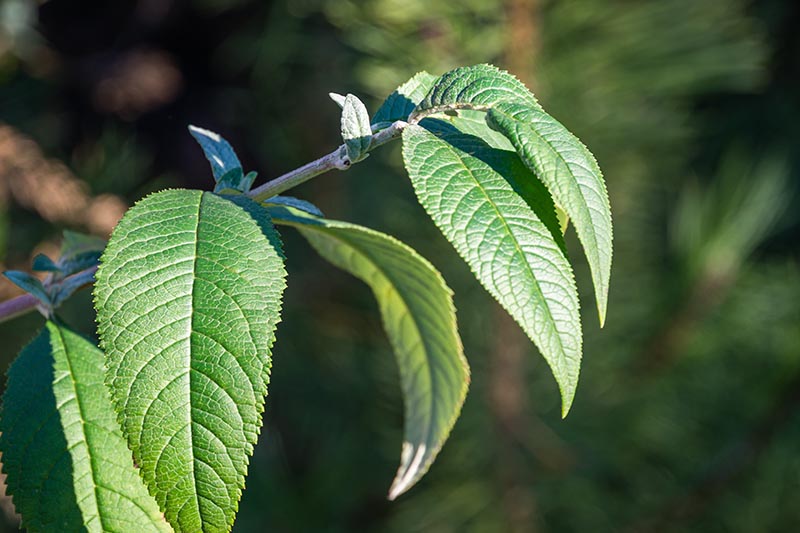
The trick is to take softwood cuttings early in the summer when plants are not blooming, using a sharp tool to snip a four- to six-inch piece from the tip of a healthy stem.
Make your cut just below a leaf node and strip the leaves off the bottom third of the cutting.
Avoid taking cuttings from plants that are blooming, or remove any flower buds – this was something I didn’t bother doing as a newbie gardener. To encourage bushier foliage, pinch out the top leaf bud to encourage lateral growth.
Fill a small pot (any size works, provided it has drainage holes) with a peat and perlite mix, and wet the medium thoroughly.
Bonide Bontone II Rooting Powder
To induce quick, robust rooting, you can dip the bottom third of the cutting in a rooting hormone such as Bonide Bontone II Rooting Powder, available at Arbico Organics.
But this is not essential and butterfly bush cuttings will root easily without it.
Stick the cutting into the pot, fully submerging the bottom third of the stem in the medium.
Place the pot in a bright, warm location and keep the medium moist. You may cover the pot with a layer of plastic wrap or a plastic bag to help to keep it from drying out.
It will take about three to six weeks for your cutting to produce strong roots. To check if it is ready for transplanting, gently tug on the cutting. If it’s rooted, you’ll feel some resistance.
At this point, it is ready to be planted into a bigger pot or straight into your garden!
From Seed
Provided your butterfly bush is not a sterile hybrid, each flower will produce a pod or capsule full of fine, viable seeds.
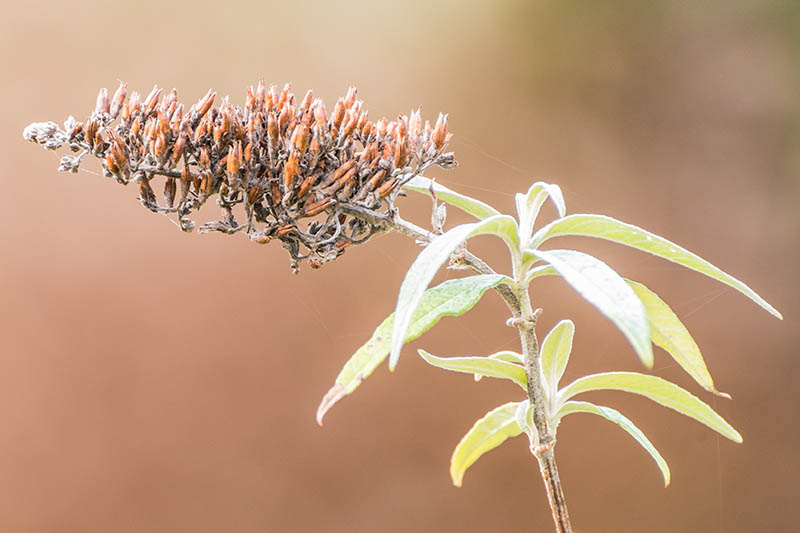
You can collect the seeds once they are dry and before they are spread by the wind. Cover the entire panicle with a paper bag to avoid losing any of the tiny seeds and clip it off at the stem. Crush and shake the bag to release the seeds.
Alternatively, allow the seeds to disperse naturally, and watch for the inevitable flush of seedlings in the spring. Once they are strong young plants with four true leaves, they can be dug up and transplanted wherever you wish.
If you collect and save seeds to sow into your garden in late spring or early summer, keep them over the winter in a cool, dry place.
In late winter or early spring, fill a seed tray with a loose and well draining propagation medium and moisten it with water.
These seeds are tiny and difficult to plant individually, so mix a tablespoon of seeds with a handful of light builder’s sand and sprinkle the surface of the seed tray evenly with the mixture, lightly tapping the seeds into the medium with your finger.
The fine seeds should not be covered, as they need light to germinate.
Place the tray in a warm, bright area and keep moist by spritzing with water as needed. After about three weeks you should see green butterfly bush babies poking out of the medium!
When the little plants have four true leaves, carefully remove each (or as many as you want to keep) from the seed tray and transplant into small three- or four-inch pots filled with a standard dampened potting mix, or soil amended with compost.
Keep your new transplants moist and in a sunny location. After the last frost, you can start to introduce the plants into the outside world to harden them off.
Over the course of a week, leave them outdoors in a protected, part sun location, and gradually increase the amount of time they spend outside and the amount of sunlight they receive.
Make sure they are used to full sun and some wind before you transplant into the garden.
In late spring or early summer, when all risk of frost has passed, pick a spot in the garden with plenty of space for the plant to grow, well drained soil, and unlimited sunshine. Allow six to 15 feet between plants, depending on the variety.
Dig a hole slightly wider and deeper than the pot. Remove the plant from its container and set it in the prepared hole. Backfill with soil, tamping down gently to remove any air pockets, and water in well.
By Division
Butterfly bushes grow tall and wide. If you’d rather have two than one giant one, try dividing your plant.
In the late fall or early spring, dig up your mature plant. You can either divide the roots by hand or separate the plant into two or three pieces using a sharp shovel.
Make sure each division has at least three stems and lots of roots attached, and plant them where you want them in your garden.
Transplanting
Before planting in the early spring, water the potted plant well until water runs freely from the drainage holes.
Dig a hole a bit wider and deeper than the pot size, loosen the soil in the bottom, and place the pot in the middle of the hole. Check that the surface of the plant’s soil is only an inch below the ground level.
Place the plant in the hole and fill it in with soil, then water deeply to finish.
Butterfly bushes won’t protest a layer of mulch applied after planting, and this will help keep roots safe from frost in colder climates. Keep the mulch an inch or two away from the stems, laying down a two- or three-inch mat extending a third of the width of the bushes’ spread.
How to Grow
Butterfly bushes are a cinch to care for. Often the only maintenance required is a hard pruning once a year, to keep their vigorous growth in check.
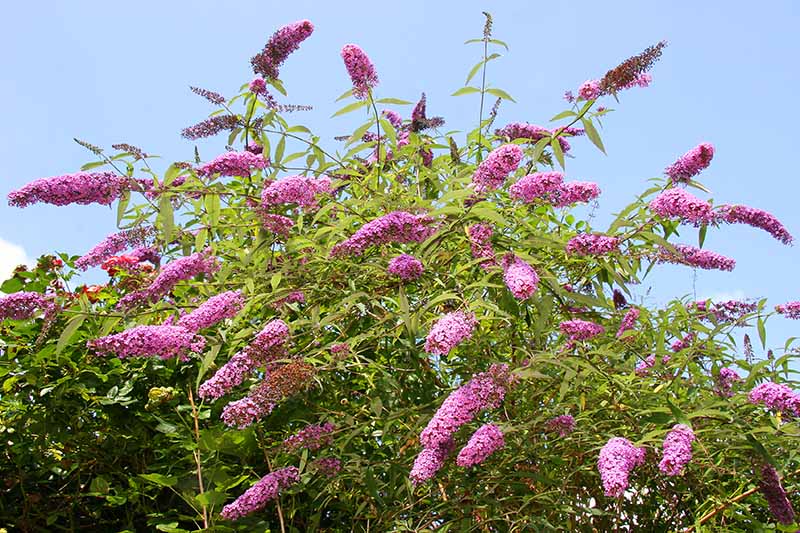
This shrub is relatively cold hardy and will tolerate Zone 5 winters if you protect the roots with a thick layer of mulch before winter hits. The cold could even do your pruning for you, killing the plant down to the ground but sparing the roots for another season of color.
These bushes will grow well in a variety of soil types, preferring a pH range of 5.5-6.5, and tolerating semi-arid sandy soils to moist clay mixes.
Though butterfly bushes can survive in lean soil with minimal nutritional requirements, doing a soil test can’t hurt – it will help to determine if the pH is ideal and if there are any nutrient deficiencies before you plant.
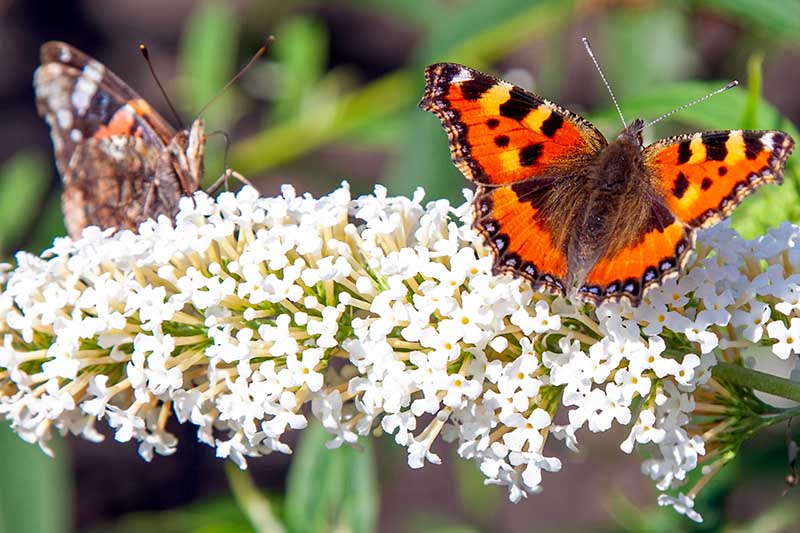
Butterfly bushes – and their insect visitors – prefer sunny locations, and will bloom from spring through to the end of summer and sometimes into the fall.
Not picky about water, mature plants can thrive without much attention. Once established, these plants are very drought and heat tolerant, but will produce more flowers if watered occasionally during very dry spells.
To decide when water is needed, check the soil about four or five inches down. If it’s dry, soak the root area. If it’s damp, watering is unnecessary.
Fertilize with a balanced slow-release fertilizer in the spring.
Growing Tips
- Plant in full sun for a summer filled with blooms and butterflies
- Prune annually
- Water when the soil is dry four or five inches deep
Pruning and Maintenance
Butterfly bush will grow wild if you let it, self-seeding and spreading into new areas of the garden, or growing vigorously in terms of height and spread.
It flowers on new wood, so pruning aggressively in late winter or early spring will help to ensure more flowers in the summer.

Always use sharp, clean pruners to prevent the spread of disease.
Proper butterfly bush pruning can seem harsh, but it’s necessary. Prune back to the base of the shrub until there are only two or three buds left on each stem, about 12 inches from the ground.
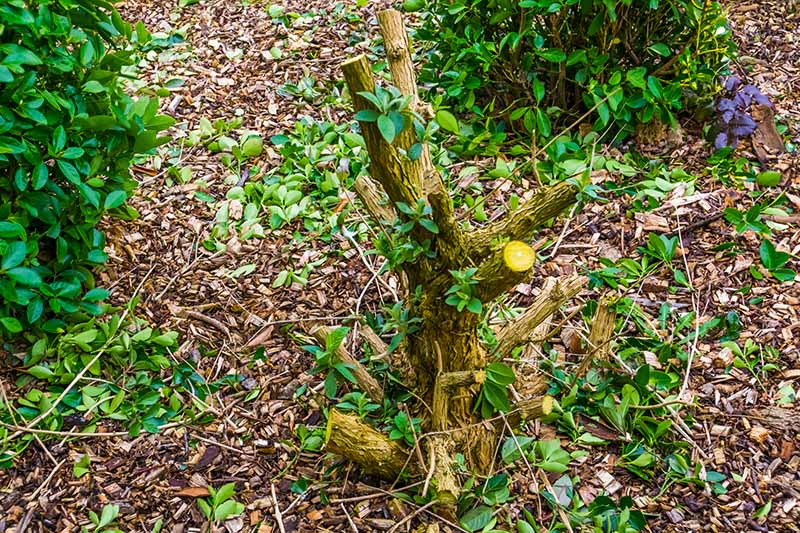
During the growing season, remove spent flowers to encourage the shrub to rebloom into autumn.
If you are not keen on having little butterfly bush plants sprouting up all over your yard, cut off the flower heads before they set and spread seed.
This isn’t necessary if you are growing a sterile cultivar, though you may see a few seedlings pop up occasionally with some varieties nonetheless.
If the bush grows out of control during the summer, you may also prune individual stems to keep the bush shapely.
Species to Select
Butterfly bush boasts a massive list of cultivars in varying colors. Meanwhile, plant breeders continue to produce more color options and more compact cultivars.

B. davidii is the most common species grown in gardens today, and it exhibits vigorous growth, green leaves, and bright bloom colors.
Nature Hills Nursery offers a variety of options, with bloom colors ranging from whites to pinks to dark purples.
Buzz™ ‘Hot Raspberry’ is one of my favorite cultivars, sporting a compact growth habit, and bright pink-purple, fragrant flowers.
Plants reach a mature height of three to four feet tall, with a spread of three feet.
You can find plants in quart-size containers available from Nature Hills Nursery.
B. x weyeriana is a noteworthy hybrid, the first cross between B. davidii and a South American species, B. globosa. Bred by and named after William van de Weyer, a British Army officer who was at home on leave during the First World War, Weyer’s aim was to produce large flowers with a golden color.
The resulting hybrids – some new, some old – come in several delicious colors, including yellow, deep pink, blue, and various shades in between, as well as bicolors.
These are available in quart-size or #3 containers via Nature Hills Nursery.
Only some of these cultivars are considered sterile, so be sure to check product descriptions carefully if growth is restricted in your area.
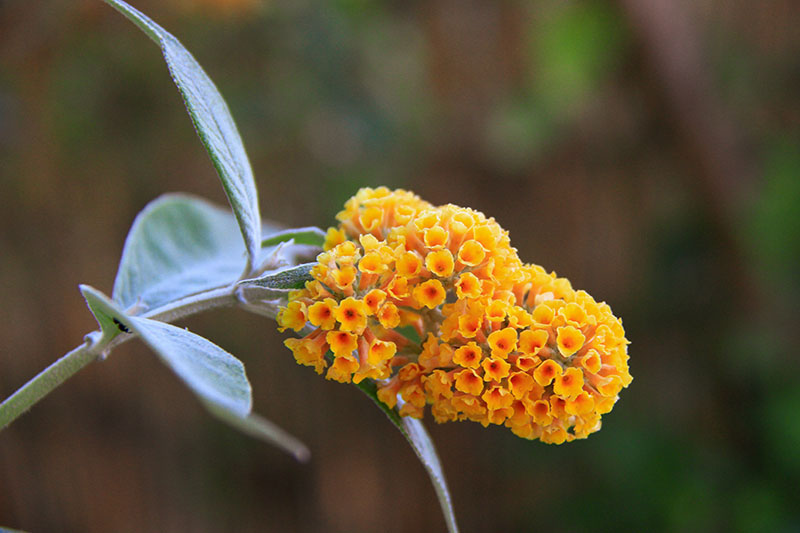
For something a little different, try B. alternifolia. As its name suggests, the alternate-leaved (or fountain) butterfly bush produces alternate, lanceolate foliage on long stems with a draping habit.
Very hardy and tall, this species blooms in the spring on old wood, so it should not be pruned in the winter or early spring like most butterfly bushes. Rather, be sure to prune this species soon after blooming.
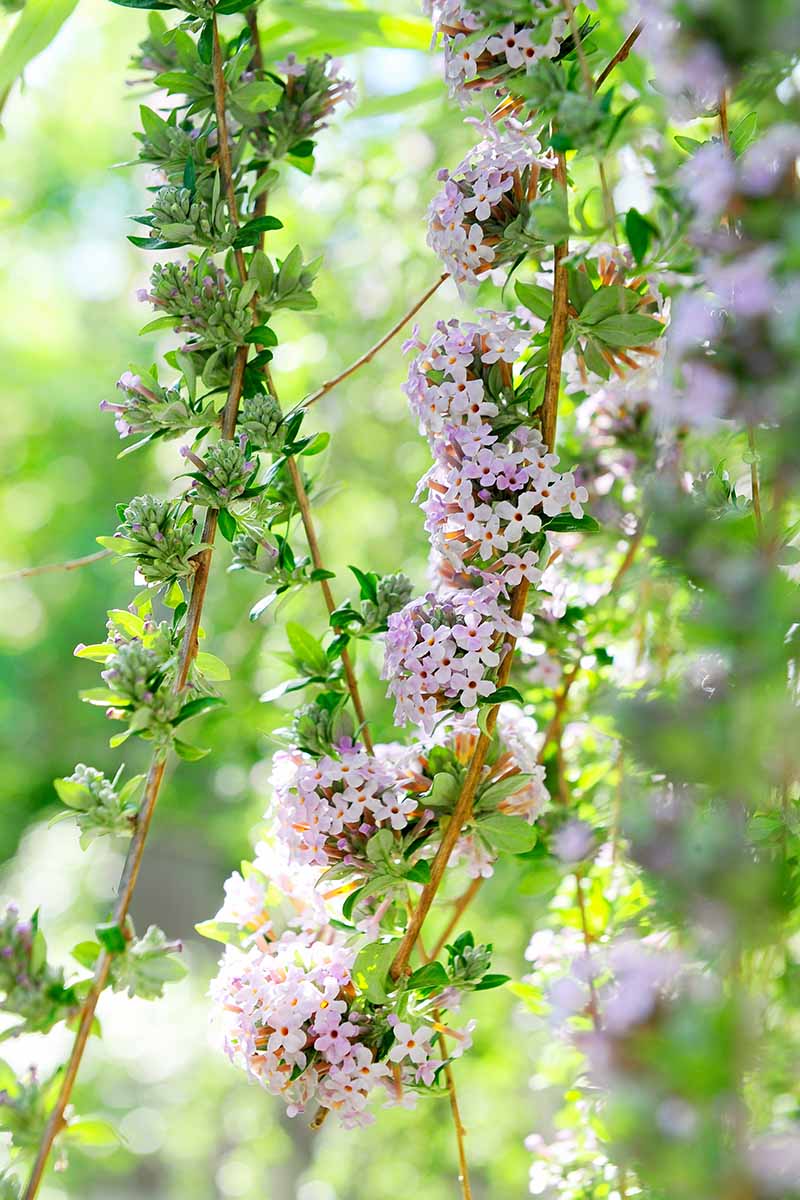
If you are looking for more unusual foliage and blossoms, search for B. fallowiana, aka summer lilac.
B. fallowiana has felted, silvery foliage and white to lavender blooms, giving it an attractive frosty look.
Lindley or weeping butterfly bush, B. lindleyana, is the little sister of the genus. Growing only four or five feet tall at maturity, it sports small, dark green leaves and fragrant lavender to purple flowers.
Want More Options?
Be sure to check out our supplemental guide, “17 of the Best Butterfly Bush Cultivars,” to find the best variety for your yard and garden.
Managing Pests and Disease
Butterfly bush is deer and rabbit tolerant, and other than a few pests and diseases that may cause problems, it is relatively unbothered.
Here are the top three to keep an eye out for:
Spider Mites
Spider mites can become an issue for most types of plants during hot, dry weather. Infestations are inconspicuous – until the leaves are covered in webbing and stippled with feeding marks.
Try washing them off with hard jets of water from the garden hose. If they keep coming back, try a horticultural oil spray such as this one from Monterey, available at Arbico Organics.
Keep in mind that these bushes attract a wide variety of butterflies and other pollinators when in bloom. Avoid pesticide use whenever possible, to prevent causing harm to pollinators.
Root-Knot Nematodes
Preventive care is the most effective way to protect the health of your plants and prevent root issues. Well draining soil is imperative to prevent rot, and meeting your plants’ nutritional needs will help to keep them healthy and thriving.
Root-knot nematodes (Meloidogyne spp.) are microscopic worms that invade and feed on plant tissue. They can become an issue for plants when the soil is oversaturated, which allows them to thrive and spread.
If you notice yellowing, wilted leaves or stunted growth, you may want to dig down and have a look at the roots. If there is a root-knot nematode problem, the roots will have small galls or swellings, and might be stunted and discolored.
Once root-knot nematodes are present it’s hard to get rid of them. Learn more about root-knot nematodes in our guide.
Downy Mildew
Presenting as yellow or light brown spots on the upper side of leaves with corresponding fuzzy white or light gray spots on the under side, downy mildew is quite ugly. It is caused by the water mold (oomycete) Peronospora hariotii, which prefers cool, damp weather and wet leaves.
Prune away diseased leaves and branches, and avoid getting the foliage wet when you water. Try watering in the morning, so the leaves can dry before the cool evening sets in.
This will help to reduce spread and combat the development of optimal conditions for the growth of this pathogen.
Plant your bushes with plenty of room to grow, to avoid crowding and a lack of airflow.
If the disease continues to spread, you may try remedying the problem by applying a fungicide. Avoid using chemical fungicides when plants are in bloom, as some can negatively impact the insects feeding on the plant.
Thyme Guard, available at Arbico Organics is an organic, naturally-derived product that is safe for pollinators.
Best Uses
Because they attract butterflies with their large, colorful, sweet-smelling clusters of blossoms, butterfly bushes look great mixed in with leafy shrubs that don’t flower in the summer, to provide an added pop of color.
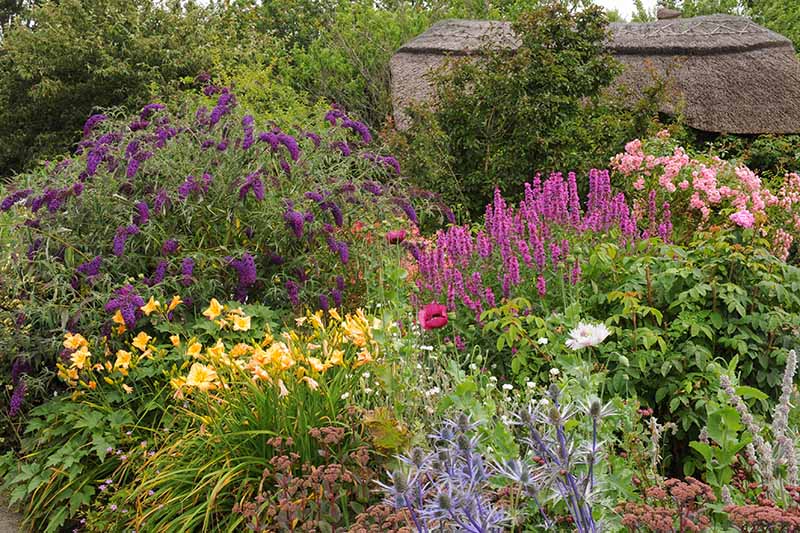
Try growing them with other plants that will host native butterfly caterpillar larvae and serve as a food source, such as milkweed, helianthus, and members of the carrot family, such as dill and fennel.
Their textured habit and bright arching blooms makes them an excellent backdrop for perennial borders and gardens.
Quick Reference Growing Guide
| Plant Type: | Deciduous flowering ornamental shrub | Flower / Foliage Color: | Various including white, pink, purple/green |
| Native to: | Asia, Africa, tropical areas of the Americas | Maintenance: | Low |
| Hardiness (USDA Zone): | 5-10 | Tolerance: | Drought, heat, rabbits, deer, salt |
| Season: | Summer | Soil Type: | Average |
| Exposure: | Full sun | Soil pH: | 5.5-6.5 |
| Spacing: | 6-15 feet | Soil Drainage: | Well-draining |
| Planting Depth: | Surface (seeds), depth of root ball (transplants) | Attracts: | Butterflies and other pollinators |
| Growth Rate: | Vigorous | Uses: | Borders, backdrops, perennial gardens |
| Height: | 3-12 feet | Family: | Loganiaceae |
| Spread: | 3-15 feet | Genus: | Buddleia |
| Water Needs: | Low | Species: | alternifolia, davidii, fallowiana, lindleyana,x weyeriana |
| Common Pests: | Spider mites, root knot nematodes | Common Diseases: | Downy mildew |
Buddleia Offers Both Bloom and Butterfly Color
As a bush that provides and attracts color, Buddleia makes a beautiful addition to the garden.
The loose, airy habit of this bush adds dimension and plumed texture, and the variety of butterflies, birds, and bees it attracts makes the garden feel alive.
Would you add a butterfly bush to your garden? Is this plant considered invasive in your area? Let us know in the comments section below!
Have a peek at these articles next for information about growing more colorful and pollinator friendly plants in the garden:
- Promoting Pollination by Design: How To Attract Pollinators
- Why You Need Milkweed: A Guide to Growing Asclepias
- 19 of the Best Perennials For Late Summer Color
© Ask the Experts, LLC. ALL RIGHTS RESERVED. See our TOS for more details. Product photos via Arbico Organics and Nature Hills Nursery. Uncredited photos: Shutterstock. With additional writing and editing by Allison Sidhu.
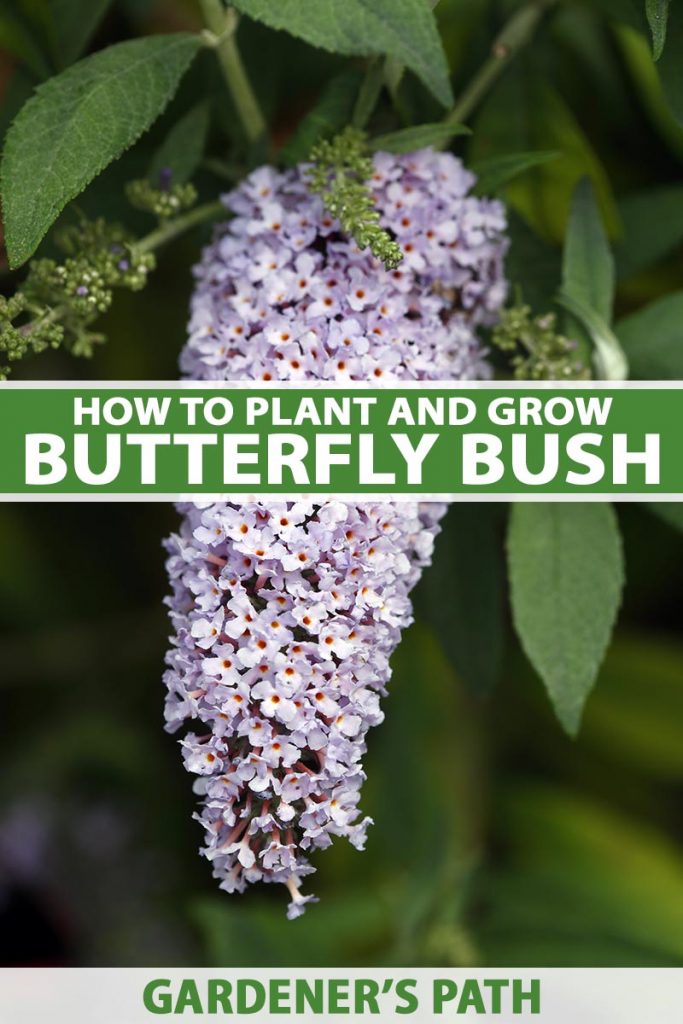
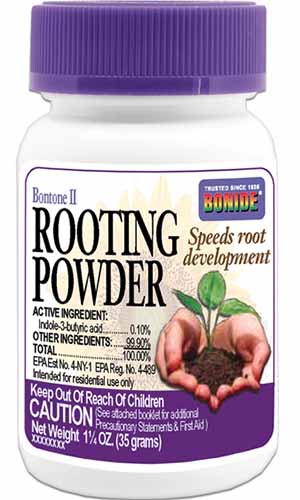

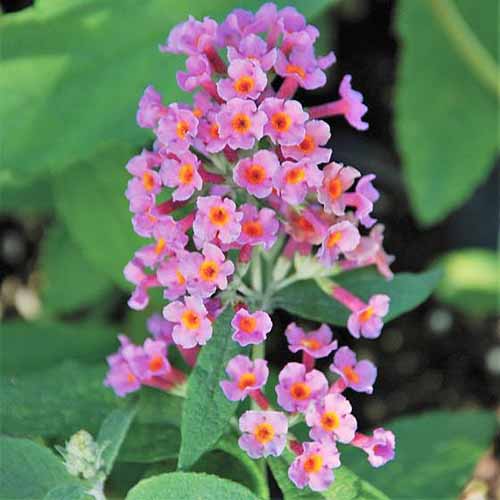
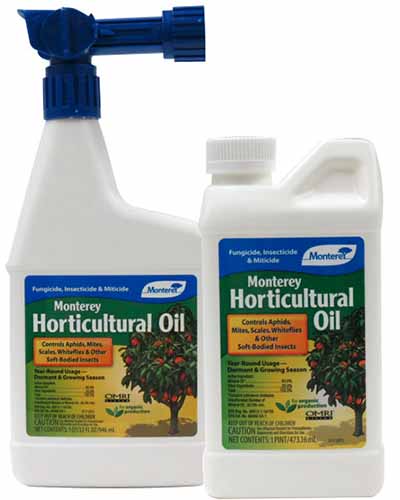
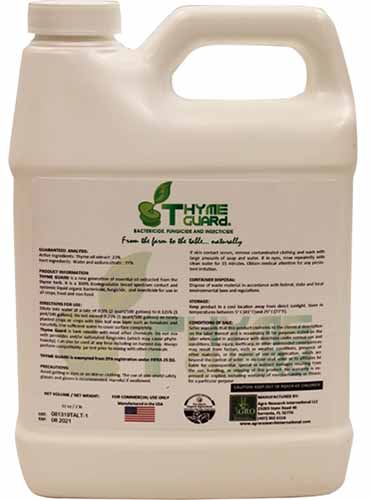
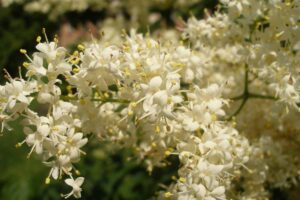
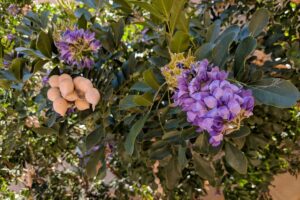
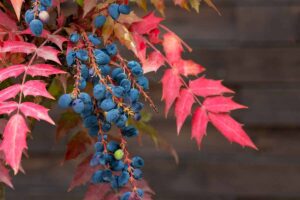
I just bought my first Black Knight Buddleia. Thank you for sharing all this wonderful information. I can’t wait to see the beautiful blooms and pollinators.
Thanks Tomi! Black Knight is a stunning cultivar, good choice! I’d love to see some photos when it flowers and of the pollinators that visit, so feel free to upload pictures and keep us updated on how it goes!
We have yellowing leaves toward the bottom of our butterfly bushes. The bushes are two years old they have been planted in regular topsoil black dirt and not clay. We water them once a week and we do not fertilized them. We are not sure they are being overwatered or under watered. We live in south eastern Iowa where it is hot and humid, zone five. Can anyone help us?? Thank you.
I just bought my first black knight buddleia and am wondering if it will do well in a large container. Mine is in a three gallon grower’s pot right now. Also, my neighbor, who can grow anything, advised I shouldn’t transplant it until after it stops blooming (it’s covered with yet-to-open blooms). Ditto for my dwarf firebush, which just arrived a couple days ago and is covered in red/yellow blooms. It’s not in a pot but is a bare root which is protected by several moistened layers and covered with a plastic baggie tied with a zip tie. Thank you!… Read more »
Hello Janis! Congratulations on acquiring these beautiful bushes. Your neighbor is correct about not transplanting the three-gallon pot buddleia until after it’s done flowering. That’s because it is putting all its energy into producing those blooms, so it won’t have any left for coping with the stress of the move. I imagine it’s already mid to late spring in your area, so you’ll probably need to wait for fall to transplant. The bare-root butterfly bush may have to go into a pot even though it’s not the ideal time of year. Would you take a look at the seller’s advice… Read more »
Thank you, Rose, for your advice about waiting until fall to transplant my 3-gallon container buddleia. The bare root plant I received is a dwarf firebush that arrived already in full bloom. My plan is to plant that in a container as well, but I think you’re right in that I may have to put it in soil before fall. I’ve had no advice from the grower about it, just what I have read online about how to care for the firebush, soil pH, etc. Perhaps if I wait till the current blooms die, I can carefully transplant it in… Read more »
Aw, Janis, you are so very welcome. I hope your plant is happy and healthy.